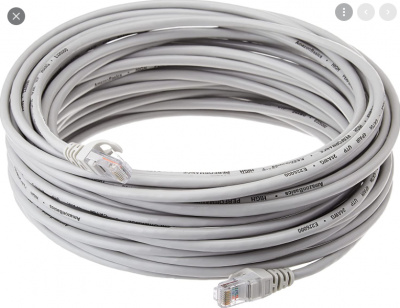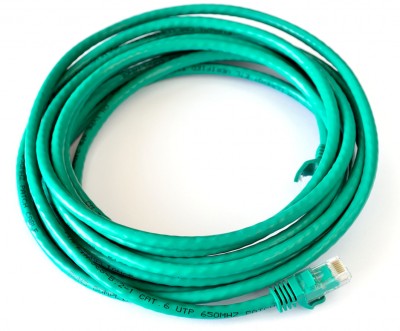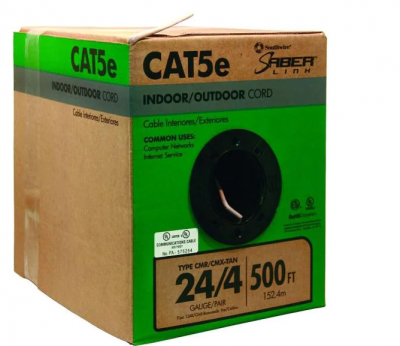How to Choose a Security Camera
— Tom Clark 2021/12/02 12:19
There's so many ways to go when looking into security cameras, so I'm just going to cover my case roughly. Keep in mind this is late 2021 information and that could change in a year so… reader beware.
Here are the features I was looking for and discuss in this article:
- POE (Power Over Ethernet)
- Wireless
- ONVIF (Open Network Video Interface Forum)
- Blue Iris
- PTZ (Pan Tilt Zoom)
- 5x Optical Zoom
- 5 Megapixel or better
- Audio
- Outdoor
- Night Vision
I suggest going through Amazon because of their no hassle return policy. If you end up getting a camera that you just don't like you should have no problem sending it back to Amazon for a full refund. I got four different brands and models and sent two models back I didn't like. Then replaced those two sendbacks with the models I found to be satisfactory.
I didn't want any wifi cameras. Why? Well, because all cameras have to have power and if the have to have power, you have to run some sort of wire to them.
One of the options for powering a camera is power over ethernet (POE). So ethernet cable comes in a few varieties but I run category 5e cable (aka Cat5e) with Cat5e/RJ-45 connectors. That's plenty good enough for a 1GB switch. If you want to spend the extra money you can go up to category 6 cable (aka Cat6) with Cat6/RJ-45 connectors. I think that the Cat5e/RJ-45 connectors do not work with Cat6 cable? I don't know because I have never used Cat6 cable.
As you can see they look identical. But there's no question Cat6 is better, but it's overkill for most home networks IMHO.
Okay so you can send a small amount of electricity through these cables. I suggest getting a good quality indoor/outdoor roll of cable. The jacket will be a bit thicker and a bit more rugged overall. I think it's worth the money for indoor/outdoor vs indoor only. I think this is the brand I got:
Okay so this cable will not only connect your cameras video feed to your home network, it will also can provide power to your cameras provided (1) your camera is POE (power over ethernet), and (2) you have a network POE switch with enough wattage to supply your POE cameras.
Here is an 8 port poe switch with 123 watts total power, and 30 watts max per port. I think most security cameras are going to draw around 20 watts of power at peak but I'm not sure.

NETGEAR 8-Port Gigabit Ethernet Unmanaged PoE Switch (GS108PP) - with 8 x PoE+ @ 123W Upgradeable, Desktop, Wall Mount or Rackmount, and Limited Lifetime Protection
Available on Amazon for about $140 when not on sale.
So to review up to this point. My solution to get the video and the power to my home computer network was to have POE cameras and to add a POE network switch. Because I have a wired connection, I don't want or need a wifi camera. Again, you have to run power to your cameras, one way or another and network POE switch solves that plus it also doesn't clog up your wifi access points with a constant flow of video data. All of the video and power handled by a single cable (per camera) is so simple and elegant all the other solutions seemed rather poor in comparison.
Next, because I decided to go with 3rd Party software running on a PC to control the whole system, I needed cameras compatible with that software. Any camera that supports ONVIF I think will work with software that also supports ONVIF. ONVIF stands for “Open Network Video Interface Forum”. But I also checked on the Amazon description/questions to make sure people were saying the cameras were compatible with Blue Iris.
The next feature I was looking for was PTZ (Pan Tilt Zoom) capability with the zoom being 5x optical. PTZ adds about $100 to the cost of a camera at the lower end of security cameras. You have to figure out how you want to run your cameras, too. So it would be cheaper to have 8 stationary cameras ($400 – each $50) rather than 4 PTZ cameras ($600 – each $150). So think about it, with 8 stationary cameras you are getting 8 streams of concurrent video but they are pointed in one spot and remain at that spot. But if you went with 4 PTZ cameras you only get 4 streams of concurrent video, however, you get use software to have your cameras sort of do an automatic patrol which isn't as good as stationary coverage because you might miss something when a camera turns away. On the other hand, with the zoom function you can program it to zoom in and out as needed, so when I setup my camera I have it zoomed 5x to check the shed, and 1x to check the front door.
In the end I think stationary cameras are, in terms of security, better because you get 8 concurrent viewpoints. However, I didn't want 8 cameras around my home. I figured one per each side of the house was good enough security for me so long as I could program the cameras to patrol the entire property.
Of course, there is the option of having some mix of stationary cameras and PTZ cameras, but I went with one PTZ camera per side of the house.
I didn't want to spend any more than $150 per camera and at that price point you can get 5x optical zoom at 5 megapixels. At the time of my purchase anyway. I think this level of zoom is more than sufficient for your standard home lot in your standard neighborhood. At that price I could also get audio. Some models have no audio, some only have a mic (one way audio) and some have a mic and speaker (two way audio) and some are capable of audio but you might have to purchase a mic and-or speaker for the camera. For my price point, I got 2 cameras with just a mic (record audio) and 2 cameras with mic & speaker (send and record audio). The cameras with both mic and speaker I stationed near the entryways of the house so I could tell solicitors to bugger off without having to get my fat butt out of my computer chair. I thought that would be fun!
You definitely want an outdoor camera if the camera is going to be outside and exposed to the elements. If you have large eaves you might get away with an indoor camera (which can save you a lot of money on a PTZ camera). I did get one indoor camera and tried it outdoors and it worked fine, but if you live in an area that gets very cold and-or very hot, I think the indoor camera might just give up the ghost, especially any PTZ capability a lot sooner than an outdoor camera. Still, I seriously considered getting the cheaper indoor models and then replacing them with the outdoor models if they ever spit the bit. In the end, though I did get outdoor rated cameras.
The final thing I want to cover is this. I think more home invasion and robberies happen at night, so far that reason you are going to want to make sure you get a camera with decent night vision. I really don't know how to rate it, but I got my cameras from Amazon and as long as I can identify my family members with it, that's good enough for me. I'd like to get good enough quality for the police to identify trespassers, but I am not willing to spend more than $150 per camera so the best night vision I can get for that price point on a PTZ camera is what I settled for.


